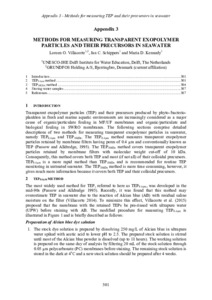| dc.contributor.author | Villacorte, Loreen O. | |
| dc.contributor.author | Schippers, Jan C. | |
| dc.contributor.author | Kennedy, Maria D. | |
| dc.date.accessioned | 2019-01-25T14:48:32Z | |
| dc.date.available | 2019-01-25T14:48:32Z | |
| dc.date.issued | 2017 | |
| dc.identifier.citation | Villacorte, L.O.; Schippers, J.C. and Kennedy, M.D. (2017) Appendix 3. Methods for measuring transparent exoplolymer particles their precursors in seawater. In: Harmful Algal Blooms (HABs) and Desalination: A Guide to Impacts, Monitoring and Management. (eds. Anderson D. M.; Boerlage, S. F. E. and Dixon, M.B.) Paris, France, Intergovernmental Oceanographic Commission of UNESCO, pp. 501-507. (IOC Manuals and Guides No. 78). DOI: http://dx.doi.org/10.25607/OBP-364 | en_US |
| dc.identifier.uri | http://hdl.handle.net/11329/808 | |
| dc.identifier.uri | http://dx.doi.org/10.25607/OBP-364 | |
| dc.description.abstract | Transparent exopolymer particles (TEP) and their precursors produced by phyto-/bacterioplankton
in fresh and marine aquatic environments are increasingly considered as a major
cause of organic/particulate fouling in MF/UF membranes and organic/particulate and
biological fouling in SWRO membranes. The following sections comprise detailed
descriptions of two methods for measuring transparent exopolymer particles in seawater,
namely TEP0.4μm and TEP10kDa. The TEP0.4μm method measures transparent exopolymer
particles retained by membrane filters having pores of 0.4 μm and conventionally known as
TEP (Passow and Alldredge, 1995). The TEP10kDa method covers transparent exopolymer
particles retained by membrane filters with molecular weight cut-off of 10 kDa.
Consequently, this method covers both TEP and most (if not all) of their colloidal precursors.
TEP0.4μm is a more rapid method than TEP10kDa and is recommended for routine TEP
monitoring in untreated seawater. The TEP10kDa method is more time consuming, however, it
gives much more information because it covers both TEP and their colloidal precursors. | en_US |
| dc.language.iso | en | en_US |
| dc.publisher | Intergovernmental Oceanographic Commission of UNESCO | en_US |
| dc.relation.ispartofseries | Intergovernmental Oceanographic Commission Manuals and Guides;78 | |
| dc.rights | No Creative Commons license | |
| dc.title | Appendix 3. Methods for measuring transparent exopolymer particles and their precursors in seawater. | en_US |
| dc.type | Report Section | en_US |
| dc.description.status | Published | en_US |
| dc.description.refereed | Refereed | en_US |
| dc.publisher.place | Paris, France | en_US |
| dc.format.pagerange | pp.501-507 | en_US |
| dc.subject.parameterDiscipline | Parameter Discipline::Biological oceanography | en_US |
| dc.description.currentstatus | Current | en_US |
| dc.contributor.editorparent | Anderson, D.M. | |
| dc.contributor.editorparent | Boerlage, S.F.E. | |
| dc.contributor.editorparent | Dixon, M.B. | |
| dc.title.parent | Harmful Algal Blooms (HABs) and Desalination: a Guide to Impacts, Monitoring and Management. | en_US |
| dc.description.bptype | Manual | en_US |
| obps.contact.contactemail | danderson@whoi.edu | |
| obps.resourceurl.publisher | http://hab.ioc-unesco.org/index.php?option=com_oe&task=viewDocumentRecord&docID=22885 | en_US |
 Repository of community practices in Ocean Research, Applications and Data/Information Management
Repository of community practices in Ocean Research, Applications and Data/Information Management
